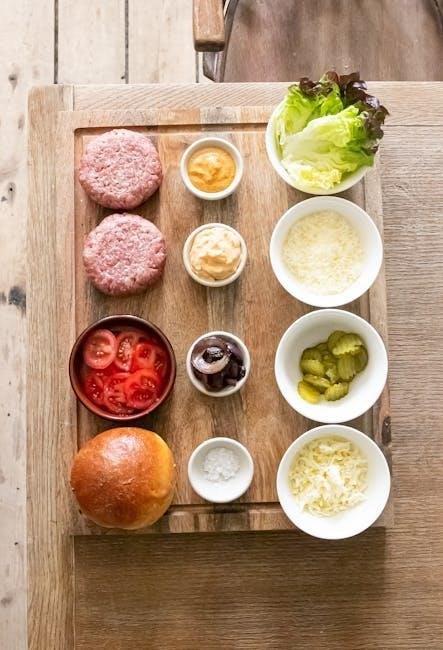
Understanding the Process and Importance of Proper Techniques
Discover how to master beef cutting with expert guidance, ensuring safety, efficiency, and premium results․ Learn essential tools, primal cuts, and techniques to enhance your meat preparation skills․
Understanding Primal Beef Cuts
Primal beef cuts are the foundation of meat processing, dividing the carcass into major sections like chuck, rib, loin, round, brisket, shank, flank, and plate․ Each primal cut has unique characteristics, such as marbling, tenderness, and flavor profile, determining its ideal use․ For instance, the chuck is tough but flavorful, often ground or slow-cooked, while the rib is fatty and tender, perfect for roasts․ The loin, lean and tender, is ideal for steaks․ Understanding these primal cuts helps in making informed decisions for further processing, ensuring optimal results for both retail and home use․ This knowledge is essential for mastering beef cutting techniques․
Essential Tools for Beef Cutting
Having the right tools is crucial for effective beef cutting․ A sharp boning knife is indispensable for precision cuts around bones and meat․ A cleaver is essential for breaking bones and portioning larger cuts․ A meat saw is useful for cutting through bones when needed․ A sturdy cutting board ensures stability during cutting․ Sharpening tools, like a whetstone or steel, maintain knife edges․ Protective gear, such as cutting gloves and an apron, enhances safety․ These tools collectively ensure precision, efficiency, and safety in beef cutting, making them vital for both professionals and home butchers aiming for professional results․
Importance of Proper Cutting Techniques
Proper cutting techniques are vital for maximizing the quality and value of beef․ Correct cuts ensure even cooking, enhanced flavor, and optimal tenderness․ Improper techniques can lead to uneven cooking, waste, or tough meat․ Precision cutting also improves presentation, making dishes more appealing․ Additionally, proper techniques reduce the risk of accidents and ensure efficient use of tools․ By mastering cutting skills, you preserve the natural qualities of the beef, making it more enjoyable for consumption․ Proper methods also help in maintaining hygiene and safety standards, ensuring a professional and consistent outcome every time․
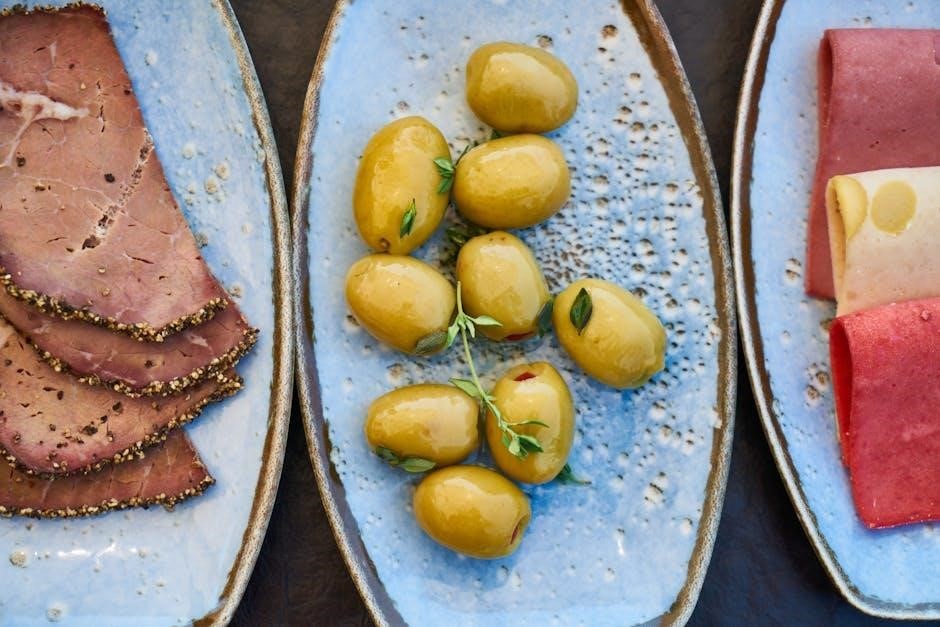
Primal Cuts of Beef
Primal cuts are the initial divisions of a beef carcass, including chuck, rib, loin, round, brisket, shank, flank, and plate․ Each offers unique characteristics and uses․
Chuck: Characteristics and Common Cuts
The chuck primal cut comes from the shoulder and upper arm area of the cow, known for its rich flavor and robust texture․ It is typically tough due to its high connective tissue but becomes tender with slow-cooking methods․ Common cuts from the chuck include ground beef, chuck roasts, and chuck steaks․ Ground beef from this area is popular for its fat content, which enhances juiciness․ Chuck roasts are ideal for braising or pot roasts, while chuck steaks are great for grilling or pan-searing․ This versatile cut is a staple in many cuisines, offering a balance of flavor and affordability․
Rib: Characteristics and Common Cuts
The rib primal cut is located between the 6th and 12th ribs and is renowned for its tenderness and rich flavor․ This area is well-marbled, contributing to its juicy and aromatic qualities․ Common cuts from the rib include the ribeye roast, rack of ribs, and back ribs․ The ribeye roast is a popular choice for its buttery texture and robust flavor, often served in high-end steakhouses․ Back ribs are meaty and ideal for slow-cooking methods like braising or barbecue․ The rib primal is a favorite among beef enthusiasts due to its exceptional taste and versatility in both roasting and smoking applications․
Loin: Characteristics and Common Cuts
The loin primal cut is located along the back of the animal, between the ribs and the sirloin․ Known for its tenderness, it is one of the most sought-after sections due to minimal muscle activity․ This primal cut is divided into the short loin and the tenderloin․ The short loin yields popular cuts like porterhouse and T-bone steaks, which combine rich flavor and juicy texture․ The tenderloin produces the filet mignon, renowned for its buttery softness and lean profile․ These cuts are highly prized in fine dining, offering a balance of flavor and tenderness that makes them a staple in upscale cuisine․
Round: Characteristics and Common Cuts
The round primal cut comes from the hindquarters of the animal, making it a lean and muscular section․ It is divided into three main sub-primals: the inside round, outside round, and rump․ Known for its firm texture and minimal marbling, the round is ideal for slow-cooking methods to achieve tenderness․ Common cuts include the round roast, rump roast, and thinly sliced round steak․ These cuts are often used in dishes like stews, stir-fries, and sandwiches․ The round is also a popular choice for ground beef due to its lean nature․ Proper cooking techniques are essential to enhance the flavor and texture of this versatile cut․
Brisket and Shank: Characteristics and Common Cuts
The brisket and shank cuts come from the breast and leg areas of the animal, respectively․ Brisket is known for its rich flavor and dense texture, often requiring slow-cooking methods like braising or smoking to achieve tenderness․ Common cuts include the flat cut brisket, point cut, and beef shank․ The flat cut is leaner, while the point cut has more fat, making it ideal for barbecue․ Beef shanks are typically used in soups, stews, and osso buco, as their connective tissue adds depth to dishes․ Proper cooking techniques, such as low-and-slow braising, are essential to enhance the flavor and texture of these cuts․
Flank and Plate: Characteristics and Common Cuts
The flank and plate cuts are lean and flavorful, originating from the belly and abdominal areas․ The flank steak is a popular cut, known for its bold, beefy taste and firm texture, often used in stir-fries and fajitas․ The plate primal includes cuts like the skirt steak and tri-tip, which are ideal for grilling or pan-frying․ These cuts are typically less tender but packed with flavor, making them perfect for high-heat cooking methods․ Proper slicing against the grain is crucial to ensure tenderness․ These cuts are also great for making corned beef or pastrami due to their fat distribution and robust flavor profile․
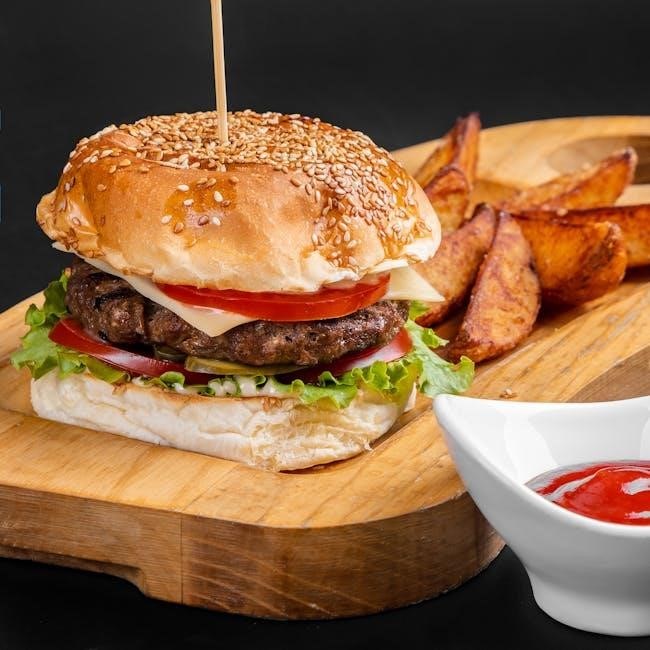
Sub-Primal and Retail Cuts
Sub-primal cuts are sections of primal cuts further divided for retail․ These include steaks, roasts, and ground beef, trimmed and portioned for consumer convenience and versatility․
Understanding Sub-Primal Cuts
Sub-primal cuts are divisions of primal cuts, further broken down into smaller, more manageable sections․ These cuts are often prepared for retail sale and include popular options like steaks, roasts, and ground beef․ Sub-primal cuts are trimmed and portioned to meet specific consumer needs, ensuring consistent quality and flavor․ For example, the strip loin is a sub-primal cut from the short loin primal, often used for strip steaks․ Similarly, the top sirloin and tenderloin are sub-primal cuts with distinct characteristics․ Understanding sub-primal cuts helps in selecting the right beef for various cooking methods, ensuring optimal results in taste and texture․
Popular Retail Beef Cuts
Popular retail beef cuts are widely recognized for their flavor, tenderness, and versatility in cooking․ Ribeye, sirloin, and filet mignon are among the most sought-after cuts, praised for their marbling and rich taste․ Ground beef is a staple for burgers and meatballs, while flank steak is ideal for stir-fries․ Chuck cuts, like stew meat and roasts, are perfect for slow-cooked dishes․ T-bone and porterhouse steaks offer a combination of tenderloin and strip loin, making them favorites for grilling․ These cuts are readily available in supermarkets and cater to various culinary preferences, ensuring there’s something for every palate and cooking method․ Understanding these cuts helps consumers make informed choices for their meals․
Ground Beef and Trim Options
Ground beef is a versatile and widely used product, made by grinding primal cuts like chuck, round, or sirloin․ Lean-to-fat ratios vary, with options like 70/30 or 80/20, offering different textures and flavors․ Trim options refer to the fat and connective tissue removed during butchering, which can be added to ground beef for richness or used separately․ Beef trim is often categorized as 50/50 or 90/10 lean-to-fat, suitable for making sausages or rendering tallow․ Additionally, pre-packaged ground beef is available in stores, labeled by cut origin, such as chuck, sirloin, or round, ensuring consistent quality and taste․ Proper handling and storage of ground beef are crucial for safety and freshness․
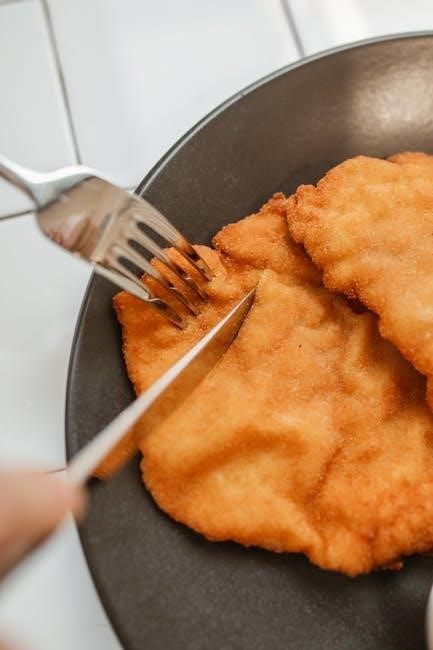
Specialty Beef Cuts
Specialty beef cuts offer unique flavors and textures, often sourced from specific regions or crafted for particular culinary needs, adding variety to traditional beef options․
Denver Cut: Origin and Characteristics
The Denver Cut, also known as the Denver steak, originates from the chuck section near the rib cage․ It gained popularity in recent years for its tenderness and rich flavor․ Known for its fine marbling, this cut offers a lean yet juicy texture, making it ideal for grilling or pan-searing․ The Denver Cut is typically cut into thin steaks and is prized for its robust beefy taste without excessive fat․ Its unique characteristics make it a favorite among chefs and home cooks seeking a balance between quality and affordability․ Proper trimming enhances its tenderness, ensuring a memorable dining experience․
Sierra Cut: Origin and Characteristics
The Sierra Cut is a lesser-known beef cut that originates from the round primal, near the top sirloin․ It is valued for its tenderness and rich, beefy flavor, making it a versatile option for various cooking methods․ Known for its lean profile, the Sierra Cut offers a balance of flavor and texture, with minimal marbling for a cleaner taste․ It is often compared to more premium cuts but remains affordable․ Ideal for grilling, pan-searing, or roasting, the Sierra Cut is gaining popularity among chefs and beef enthusiasts seeking a high-quality, cost-effective option․ Its moderate thickness ensures even cooking and a satisfying mouthfeel․
Santa Fe Cut: Origin and Characteristics
The Santa Fe Cut is a distinctive beef cut that originates from the beef belly, near the flank area․ Known for its rich flavor and fine marbling, it offers a unique combination of tenderness and bold taste․ This cut is prized for its velvety texture and robust beefy aroma, making it ideal for slow-cooking methods․ The Santa Fe Cut is gaining traction for its ability to absorb flavors during cooking, resulting in a deeply satisfying culinary experience․ Its moderate fat content ensures juiciness, while its firm structure holds up well to pan-frying or braising․ This cut is a hidden gem for those seeking a flavorful yet versatile option for various dishes․
Tri Tip: Origin and Characteristics
The Tri Tip is a triangular cut sourced from the bottom sirloin, near the rump area․ Known for its bold flavor and moderate tenderness, it is a popular choice for grilling and pan-searing․ The Tri Tip is characterized by a good balance of marbling, which enhances juiciness, and a robust beefy taste․ Its chewy texture makes it best suited for cooking methods that break down connective tissues, such as slow cooking or slicing against the grain․ Originating in the western United States, this cut has become a favorite for its rich flavor profile and versatility in both casual and gourmet dishes․ Proper preparation ensures a deliciously tender and flavorful result․
Flat Iron: Origin and Characteristics
The Flat Iron is a cut from the shoulder area, specifically the supraspinatus muscle, known for its exceptional tenderness and rich flavor․ This cut is characterized by its uniform thickness and fine marbling, which enhances its juiciness and texture․ Originating from the chuck primal, the Flat Iron is often compared to more expensive cuts due to its steak-like quality․ It is ideal for grilling, pan-searing, or oven cooking, as it develops a crispy crust while retaining a tender interior․ Its mild beefy flavor and buttery texture make it a popular choice for both home cooks and professional chefs, offering a cost-effective yet luxurious dining experience․
Tenderloin: Origin and Characteristics
The tenderloin is one of the most sought-after beef cuts, originating from the short loin section near the spine․ It is derived from the psoas major muscle, which remains underused, resulting in its exceptional tenderness․ This cut is lean, with a fine grain and minimal marbling, contributing to its delicate flavor and buttery texture․ The tenderloin is a long, narrow cut, often divided into two parts: the butt end, which is thicker and more tender, and the tail, which is narrower and ideal for dishes like Beef Wellington․ Known for its mild flavor, the tenderloin is a favorite in upscale cuisine, making it perfect for grilling, roasting, or pan-searing․ It is also commonly served as a whole roast or sliced into medallions and filets․
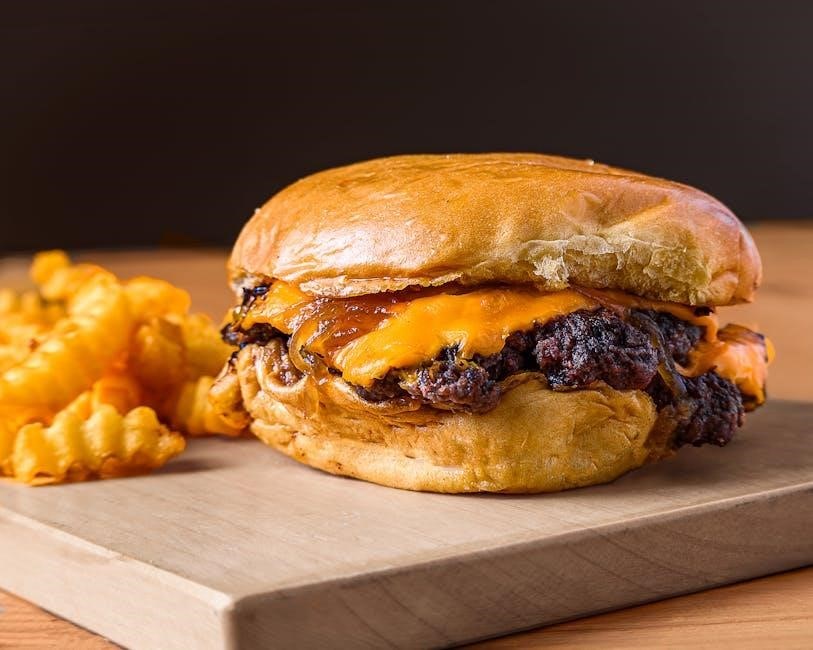
Cooking Methods for Different Cuts
Different beef cuts require specific cooking techniques to enhance flavor and texture․ Tender cuts excel with grilling or pan-searing, while tougher cuts benefit from slow-cooking or braising․
Grilling and Pan-Sealing Techniques
Grilling and pan-searing are ideal for tender cuts like ribeye or sirloin․ Preheat the grill to medium-high heat and ensure the grates are clean․ Bring meat to room temperature for even cooking․ Season generously with salt, pepper, and herbs․ Brush the grill with oil to prevent sticking․ Sear for 3-5 minutes per side, then finish at lower heat to desired doneness․ For pan-searing, heat a skillet with oil over high heat․ Sear the meat for 2-3 minutes per side, then reduce heat to medium-low to complete cooking․ Avoid overcrowding the pan․ Finish with butter for added flavor․ Let the meat rest before slicing․
Oven Roasting and Braising Methods
Oven roasting is perfect for larger cuts like prime rib or round․ Preheat the oven to 325°F (165°C)․ Season the beef generously with spices, then sear in a skillet for a crust․ Place on a roasting rack in a roasting pan, avoiding overcrowding․ Roast until the internal temperature reaches desired doneness, basting occasionally with pan juices․ For braising, Ideal for tougher cuts like brisket or shank․ Brown the meat in a pan, then slow-cook in liquid (stock or wine) on low heat․ Cover tightly and cook until tender, 2-3 hours․ Let rest before slicing for maximum tenderness and flavor retention․
Slow Cooking and Stewing Techniques
Slow cooking and stewing are ideal for tougher beef cuts, such as chuck or brisket, breaking down connective tissues for tender results․ Brown the meat first to enhance flavor, then cook in liquid (stock or wine) on low heat for 1․5-3 hours․ Use a heavy pot or slow cooker, ensuring the meat is submerged․ Adding aromatics like onions and garlic boosts flavor․ Stewing involves smaller cubes of meat cooked in a flavorful broth until tender․ Both methods require patience but deliver rich, comforting dishes․ Let the meat rest before serving for optimal texture and flavor distribution․ These techniques are perfect for hearty meals like stews or pot roasts․
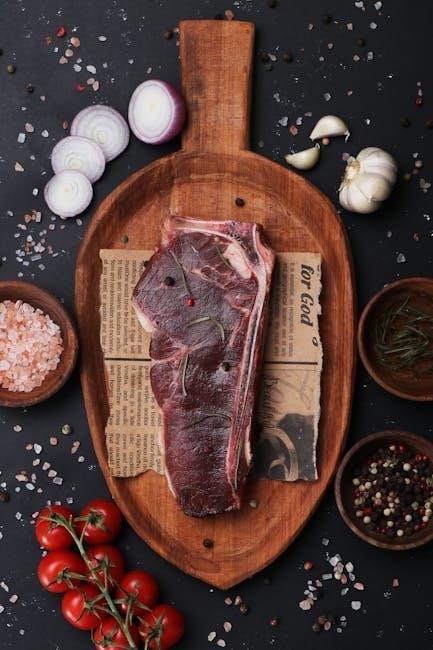
Beef Cutting Safety and Handling
Always wear gloves and goggles to prevent bacterial exposure and ensure safe handling․ Keep raw meat cold, below 40°F, and use dedicated cutting tools to avoid cross-contamination․
Proper Sanitation Practices
Sanitation is critical when cutting beef to prevent contamination; Always clean and sanitize knives, cutting tools, and work surfaces before and after use․ Use a food-safe sanitizer like bleach solution or vinegar․ Wash hands thoroughly with soap and warm water for at least 20 seconds․ Ensure all utensils and equipment are stored in a clean, dry environment․ Regularly sanitize cutting boards and trays, especially after handling raw meat․ Prevent cross-contamination by separating raw beef from cooked or ready-to-eat foods․ Dispose of trimmings and waste immediately in sealed containers․ Maintain a clean workspace to ensure a safe and hygienic beef-cutting process․
Storage and Freezing Guidelines
Proper storage and freezing are essential for maintaining beef quality․ Store fresh beef in its original packaging in the refrigerator at 32–40°F (0–4°C) and use within 3–5 days․ For freezing, wrap beef tightly in airtight, moisture-proof packaging like plastic wrap or vacuum-sealed bags to prevent freezer burn․ Label packages with the date and contents․ Ground beef and cuts can be frozen for 3–4 months, while roasts and steaks can last up to 6–8 months․ When thawing, do so in the refrigerator or in cold water, never at room temperature․ Ensure thawed beef is used immediately to maintain safety and freshness․
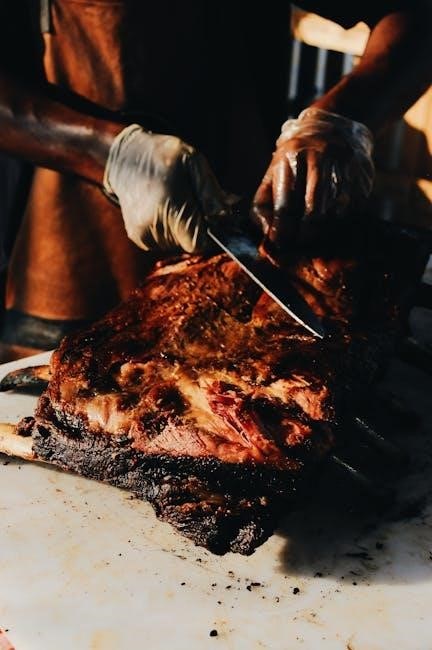
Food Safety Tips for Beef Handling
Handling beef safely is crucial to prevent contamination and foodborne illness․ Always wash hands thoroughly with soap and warm water before and after handling beef․ Use separate cutting boards and utensils for raw beef to avoid cross-contamination with ready-to-eat foods․ Sanitize all tools and surfaces with a solution of 1 tablespoon unscented chlorine bleach per gallon of water․ Keep raw beef at room temperature for no more than 2 hours․ Cook ground beef to an internal temperature of 160°F (71°C) and steaks or roasts to at least 145°F (63°C) with a 3-minute rest․ Never rinse raw beef under running water, as it can spread bacteria․ Always marinate beef in the refrigerator, not at room temperature․ By following these guidelines, you ensure safer handling and better-quality beef for cooking and consumption․
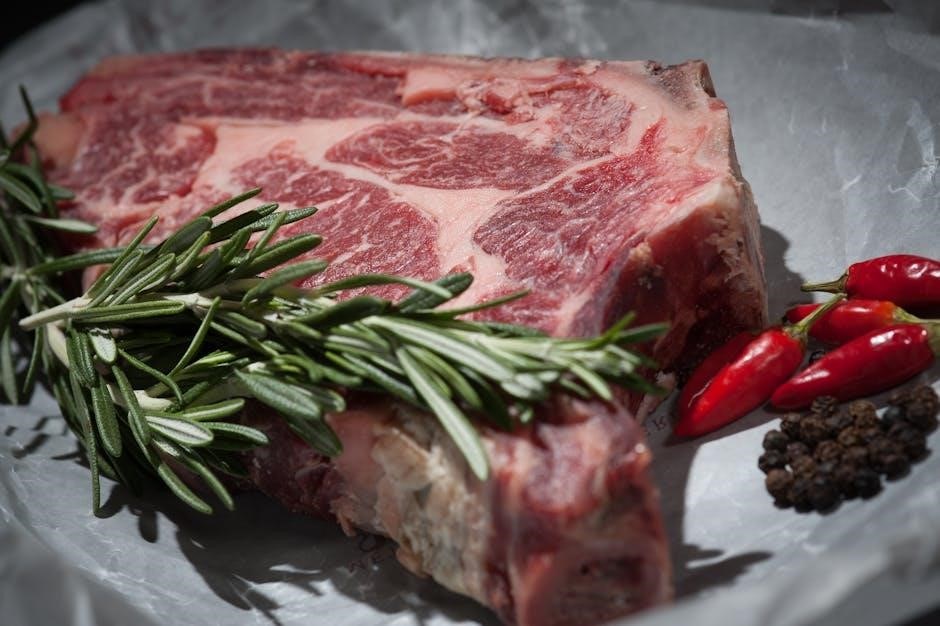
Custom Beef Cutting Options
Custom beef cutting allows for tailored cuts to meet specific preferences, ensuring optimal quality and satisfaction for various cooking needs and recipes․
Choosing the Right Beef Share
Selecting the appropriate beef share involves assessing your household’s consumption habits, storage capacity, and budget․ Consider whether a whole, half, or quarter cow best suits your needs․ Whole cows offer the most variety but require ample freezer space․ Half shares provide a balanced selection of cuts, while quarter shares are ideal for smaller families․ Think about your cooking preferences, such as the type of steaks or ground beef you use most․ Budget constraints also play a role, as larger shares may offer cost savings․ Discussing your needs with a butcher ensures you get the right cuts for your lifestyle and preferences․
Working with a Butcher: Key Considerations
When collaborating with a butcher, clear communication is essential to achieve your desired results․ Discuss your preferences, such as fat content, cut sizes, and specific beef cuts․ A skilled butcher can offer valuable recommendations based on your needs and budget․ Building trust is crucial, as they handle the meat with care and expertise․ Be open to their advice on cooking methods or alternative cuts that might suit your recipes․ Additionally, inquire about their sourcing practices to ensure the beef meets your quality standards․ Regular communication ensures transparency and satisfaction, making the process enjoyable and tailored to your preferences;
Sample Cutting Instructions and Templates
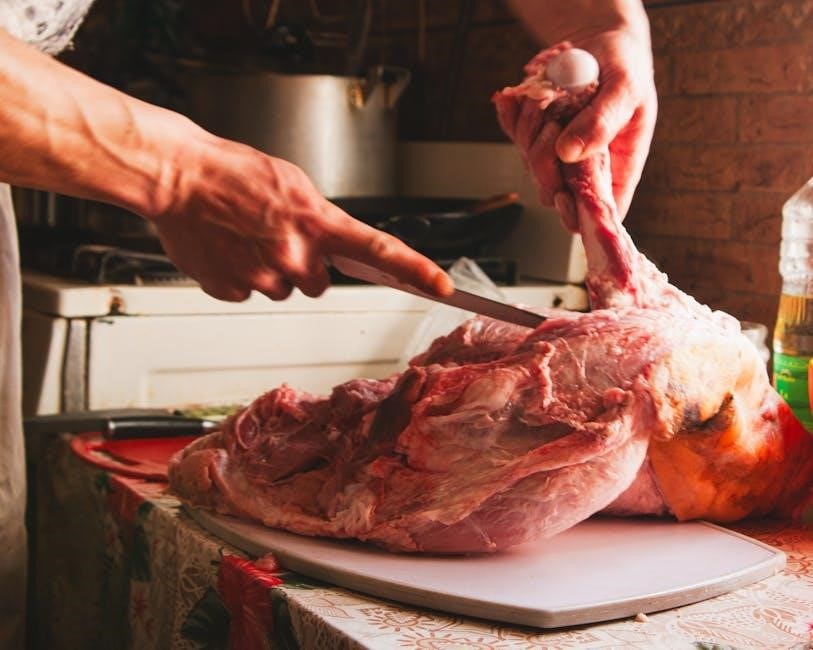
Sample cutting instructions and templates provide a structured approach to beef cutting, ensuring consistency and efficiency․ These templates often include detailed diagrams and step-by-step guides for common cuts like steaks, roasts, and ground beef․ Many templates specify the weight and thickness of each cut, making it easier to achieve uniform results․ They also offer customization options, allowing adjustments for personal preferences, such as fat content or portion size․ Visual aids, like labeled beef primal diagrams, are often included to help novices identify key sections․ These resources are invaluable for both home cooks and professional butchers, streamlining the beef cutting process and improving overall quality․
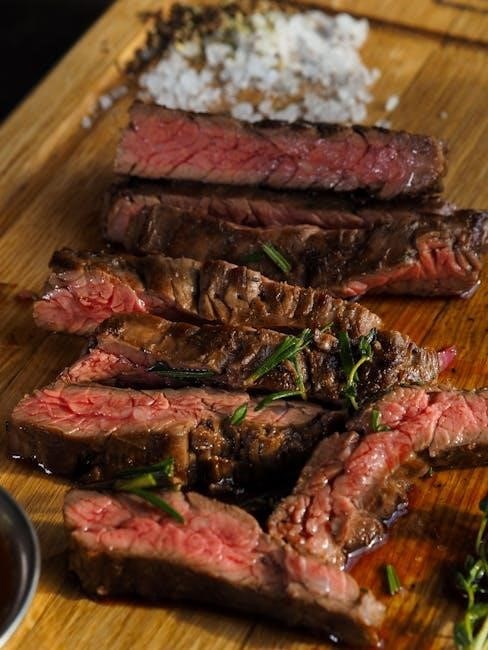
Final Thoughts on Beef Cutting Instructions
Mastering beef cutting techniques enhances precision, quality, and variety in meal preparation․ With proper tools and techniques, anyone can achieve professional results, ensuring flavorful and tender dishes․
Mastering beef cutting techniques is a skill that enhances both culinary creativity and efficiency․ Understanding primal cuts, proper tools, and safe handling practices ensures high-quality results․ Whether grilling, roasting, or slow cooking, precise cutting elevates flavor and texture․ Experimenting with sub-primal and retail cuts allows for versatility in meals․ Additionally, exploring specialty cuts like the Denver or Flat Iron offers unique dining experiences․ Always prioritize sanitation, proper storage, and food safety to maintain freshness and prevent contamination․ For those seeking customization, collaborating with a butcher or using cutting templates can streamline the process․ With practice and patience, anyone can become proficient in beef cutting, unlocking endless possibilities in the kitchen․
Additional Resources for Beef Cutting
Exploring additional resources can deepen your understanding of beef cutting techniques․ Reputable sources like the National Cattlemen’s Beef Association and the American Meat Science Association offer detailed guides and videos․ Online forums, such as those on cooking websites, provide firsthand experiences and tips from professionals․ DVDs and workshops led by skilled butchers are excellent for hands-on learning․ Books on meat cutting, like The Meat Bible, offer comprehensive insights․ Experimenting with different tools and techniques, while referencing these resources, will refine your skills․ Always cross-reference information to ensure accuracy and stay updated on the latest trends in beef cutting․